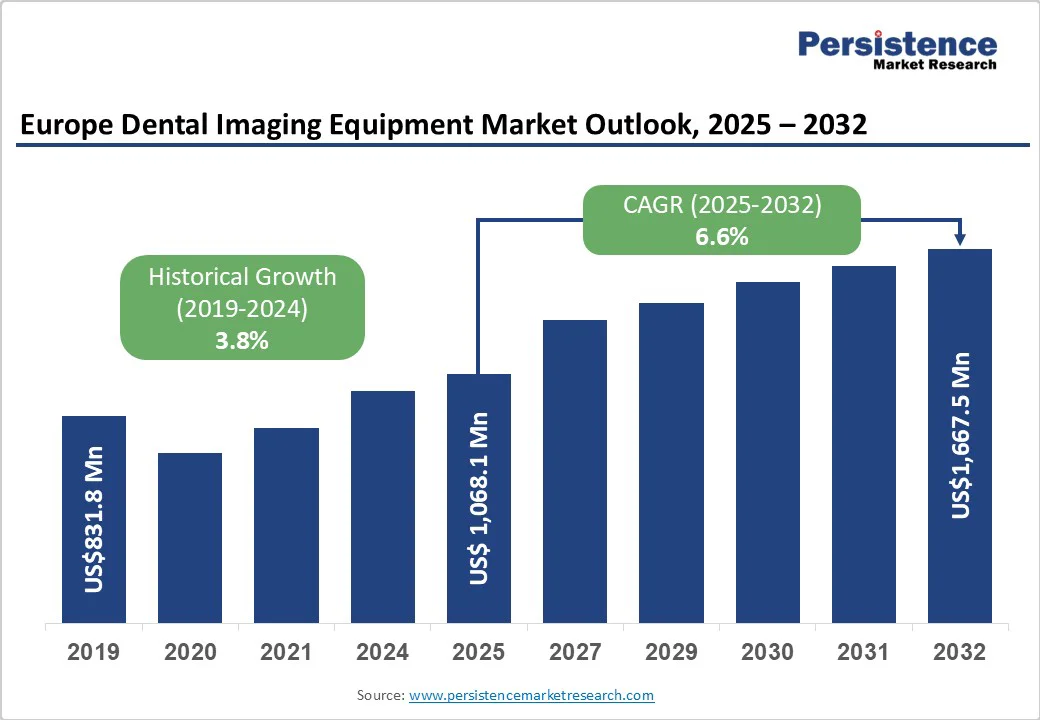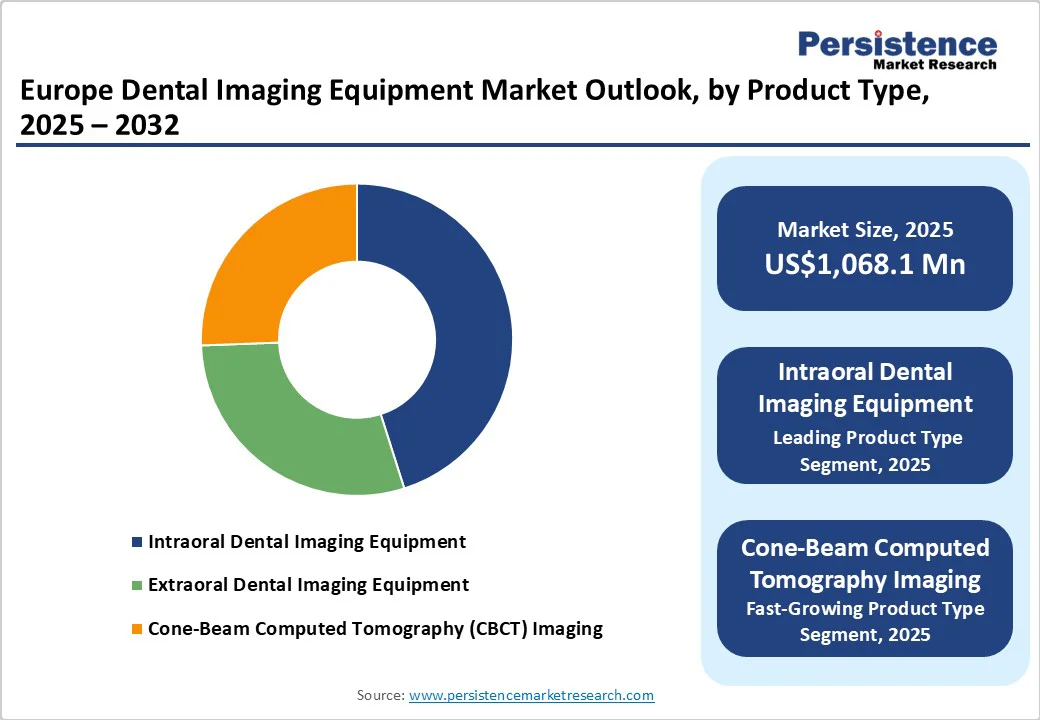ID: PMRREP33077| 199 Pages | 30 Sep 2025 | Format: PDF, Excel, PPT* | Healthcare

The Europe dental imaging equipment market size is likely to be valued at US$1,068.1 Mn in 2025 and is expected to reach US$1,667.5 Mn by 2032, growing at a CAGR of 6.6% during the forecast period from 2025 to 2032, driven by the increasing complexity of dental procedures and surgeries, which has led to a surge in demand for 3D imaging technologies.
| Key Insights | Details |
|---|---|
| Europe Dental Imaging Equipment Market Size (2025E) | US$1,068.1 Mn |
| Market Value Forecast (2032F) | US$1,667.5 Mn |
| Projected Growth (CAGR 2025 to 2032) | 6.6% |
| Historical Market Growth (CAGR 2019 to 2024) | 3.8% |

The increasing complexity of dental procedures and surgeries has led to a surge in demand for 3D imaging technologies. Traditional 2D imaging methods often fall short in providing the detailed anatomical insights required for intricate dental interventions. In contrast, 3D imaging allows a comprehensive view of a patient’s oral and maxillofacial structures, enhancing the precision and effectiveness of diagnostics and treatment planning.
With the rise of minimally invasive surgical techniques, 3D imaging plays a crucial role in pre-surgical assessments, enabling dentists and oral surgeons to visualize bone structures, assess the spatial relationships of teeth, and identify potential complications. Technologies such as Cone Beam Computed Tomography (CBCT) provide high-resolution images, allowing for accurate implant placements and orthodontic treatments.
The integration of 3D imaging with computer-aided design and manufacturing (CAD/CAM) technologies facilitates the creation of custom dental solutions, such as implants and prosthetics, tailored to each patient's unique anatomy. This combination not only improves surgical outcomes but also enhances patient satisfaction through more predictable results.
As the dental field continues to evolve, the reliance on advanced 3D imaging technologies is expected to grow, driving innovation and improving patient care in complex dental procedures and surgeries.
Generally, dentists use several sensors corresponding to different intraoral films based on size, and the expense of converting records to digital is proportional to the amount of time it takes. Bending radiography plates can harm phosphorus storage plates, necessitating replacement on a regular basis. As a result, high initial setup costs are a stumbling block to market growth. As dental imaging accessories have a short lifespan, there is more expense associated with changing them frequently.
Dentists make a significant capital investment to get their dental imaging systems up and running. Wired gadgets, excluding software, computers, and other hardware, are projected to be worth between US$11,000 and US$15,000. With the associated high cost of equipment setup and maintenance, as well as the factor of low span of equipment integrity, the market for dental imaging equipment in Europe is expected to experience an impeded growth progression through the forecasted years.
The integration of Augmented Reality (AR) and Virtual Reality (VR) technologies in intraoral scanners presents a significant opportunity within the dental imaging sector. By enhancing the scanning process, AR-enabled devices facilitate a more interactive and user-friendly experience for dental professionals, particularly during intraoral scans. These technologies allow for real-time visualization of acquired images directly overlaid on the patient's anatomy, streamlining the scanning workflow and improving accuracy.
Recent studies highlight the benefits of AR in this context, showing that the implementation of AR-HUD during intraoral scans resulted in increased image capture rates and enhanced operator preference due to improved ergonomics.
Furthermore, advancements in scanning technology, such as the 3Shape TRIOS® system, exemplify the potential of these innovations. The TRIOS scanner, known for its ease of use and high clinical accuracy, has become a staple in dental practices, with scans being performed every 1.3 seconds.
The growing demand for intuitive and effective scanning solutions underscores the importance of integrating AR and VR technologies into dental imaging. This evolution not only meets the expectations of dental professionals but also significantly enhances patient care by ensuring more accurate diagnoses and treatment planning.
Intraoral dental imaging products are anticipated to account for approximately 45% share in 2025. Intraoral and panoramic radiography, as well as 3D cone-beam computed tomography, are the most prevalent modalities for daily clinical imaging in dental medicine.
Intraoral imaging equipment experiences wider adoption in the European region owing to the efficacy of the equipment in providing clear imaging with enhanced resolution for 2D detection of cavities. Intraoral dental imaging devices facilitate the precise detection of small cavity structures, and hence, see higher adoption by dental providers as compared to imaging techniques such as panoramic radiography.
In Germany, dental imaging accounts for almost 23% of all X-ray exams. The market for dental imaging equipment in Germany is experiencing sales growth, driven by rising demand for advanced diagnostic tools and increasing prevalence of dental conditions across all age groups.
Germany is set to account for around 22% of Europe dental imaging equipment market during the forecast period. This growth is associated with rising attempts in imaging technologies to adopt implant placement techniques guided by 3D imaging and navigation in the country.

European dental imaging equipment market is moderately consolidated, with prominent players leading advancements in technology and expanding their market presence. Key companies in this sector include Carestream Dental LLC, Dentsply Sirona, Planmeca Oy, and Vatech Co. Ltd., all of which are pioneering innovative imaging solutions such as intraoral scanners, dental cone-beam computed tomography (CBCT), and 3D imaging systems to cater to the increasing demand for high-precision diagnostics.
Companies such as Dentsply Sirona prioritize the integration of seamless digital workflows, whereas others, such as Carestream and Planmeca, concentrate on diversifying their product offerings through cutting-edge 3D imaging technologies.
The industry has also witnessed strategic moves, including mergers, new product launches, and regional expansions, designed to solidify its competitive positions. For instance, Dentsply Sirona has introduced digital tools to improve clinical outcomes, while Vatech is targeting cost-conscious markets by offering budget-friendly dental X-ray systems.
Europe dental imaging equipment market is projected to be valued at US$1,068.1 Mn in 2025.
Europe dental imaging equipment market is driven by rising demand for precision diagnostics, advancements in 3D and CBCT technologies, and streamlined digital workflows.
Europe dental imaging equipment market is poised to witness a CAGR of 6.6% between 2025 and 2032.
The integration of AI-powered diagnostic tools in dental imaging equipment offers a significant opportunity, enabling enhanced precision, faster diagnostics, and personalized treatment planning, driving demand among tech-savvy dental professionals globally.
Dentsply Sirona, Align Technology, Inc., Planmeca Oy (KaVo Dental), VATECH, Midmark Corporation, and CEFLA are some of the leading industry players.
| Report Attribute | Details |
|---|---|
| Historical Data/Actuals | 2019 - 2024 |
| Forecast Period | 2025 - 2032 |
| Market Analysis | Value: US$ Mn |
| Country |
|
| Segmental Coverage |
|
| Competitive Analysis |
|
| Report Highlights |
|
By Product Type
By Dimension
By End-user
By Country
Delivery Timelines
For more information on this report and its delivery timelines please get in touch with our sales team.
About Author